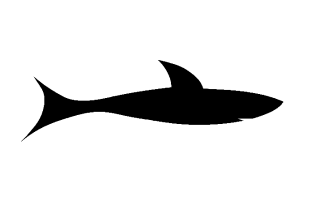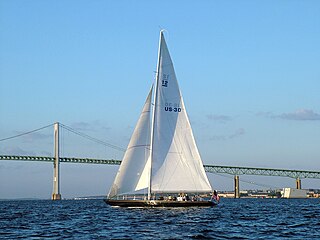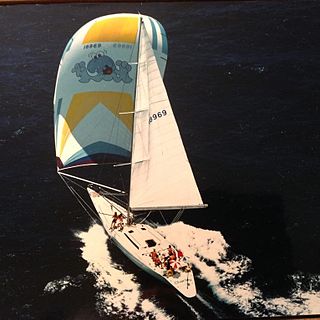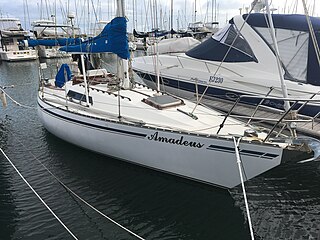
The Shark 24 is a Canadian-designed 24 ft sailing yacht which has earned itself a reputation of extraordinary reliability and longevity among sailors both in North America and Central Europe. Having been designed by George Hinterhoeller back in 1959 to cope well even with the harshest conditions found in the Great Lakes region, the vessel has proven to be well suited for extended leisure trips as well as for tough racing.

The Hobie Cat is a small sailing catamaran manufactured by the Hobie Cat Company. Hobie's line of products ranges from surfboards to catamaran sailboats to kayaks and stand-up paddle boards, though the Hobie Cat Company is most famous around the world for its catamarans. Hobie also designed a very successful monohull, the Hobie 33.
One-Design is a racing method which may be adopted in sports which use complex equipment, whereby all vehicles, gliders or boats have identical or very similar designs or models. In motor racing, it is also known as Spec series, and one-make racing.

The 12 Metre class is a rating class for racing sailboats that are designed to the International rule. It enables fair competition between boats that rate in the class whilst retaining the freedom to experiment with the details of their designs. The designation "12 Metre" does not refer to any single measurement on the boat, and is not referencing the vessels overall length, rather, measures the sum of the components directed by the formula which governs design and construction parameters. Typically 12 Metre class boats range from 65 to 75 feet in length overall; they are most often sloop-rigged, with masts roughly 85 feet tall.
The Universal Rule determined a yacht's eligibility to race in the America's Cup from 1914 to 1937 and for this the J-class was chosen. Boats built according to the rule reached their peak in the large J-class yachts. This Rating Rule is intended to calculate a rating for yachts, which can then be used to calculate its Time Correction Factor (T.C.F.) in order to have disparate yachts racing against each other. The first boat said to be built under the universal rule was Herreshoff's Doris built in 1905.

The International rule, also known as the Metre rule, was created for the measuring and rating of yachts to allow different designs of yacht to race together under a handicap system. Prior to the ratification of the International rule in 1907, countries raced yachts under their own national rules and international competition was always subject to various forms of subjective handicapping.

Ronald John Holland is a yacht designer, who came to prominence in the 1970s with his successful racing designs, and is now best known for his superyachts such as Mirabella V and Ethereal. He is now based in Vancouver, British Columbia, Canada.

The Mutineer 15 is a 15-foot (4.6 m) long fractional sloop sailboat currently manufactured by Nickels Boat Works. It has a dinghy centerboard hull, no ballast, and displaces 410 pounds. The Mutineer 15 has a 6-foot (1.8 m) beam, maximum draw of 4.08 feet (1.24 m), and has 150 square feet (14 m2) of sail area. The Mutineer 15 is commonly used for both day sailing and class racing. The Mutineer 15 can be comfortably sailed as a day sailer with a crew of four, but can also be raced with a crew of two, or even single-handed by semi-experienced to experienced sailors.

Thomas Harrison Butler, DM, FRCS(Eng) was a British ophthalmologist and amateur boat designer. He published various designs of small, traditionally built yacht and was particularly concerned with the boat's handling under sail.
HMS Packington was a Ton-class minesweeper built by Harland & Wolff for the Royal Navy. The following year she was transferred to the South African Navy and renamed SAS Walvisbaai. The ship was decommissioned in March 2001 and was sold to the Walt Disney Company in 2003 to be used in the Wes Anderson film The Life Aquatic with Steve Zissou.

There are three designs of Phantom sailboats, one is a small una rig which is often raced, another is a lateen rig that was designed after the Sunfish model sailing dinghy, and a third is a larger keelboat designed and built in Sydney, Australia.

A steam yacht is a class of luxury or commercial yacht with primary or secondary steam propulsion in addition to the sails usually carried by yachts.
Ton classes are categories used to identify classes of yachts.

The C&C 29 is a series of Canadian sailboats, that was designed by Cuthbertson & Cassian as International Offshore Rule half-ton racers and first built in 1977. The design is now out of production.

The C&C 30 is a series of Canadian and American sailboats, that was first built in 1973.

The C&C 25 is a series of Canadian sailboats, first built in 1973.

UFO 34 is a cruising and racing fibreglass monohull sailboat class. It is a sloop based on a design by Holman and Pye. The design features a spade rudder and a Bermuda rig with a large, overlapping headsail. Over 150 UFO 34's have been built both in the United Kingdom and Australia.

George Cockshott was educated at Uppingham and King’s College Cambridge. He resided at Southport, and was Vice-Commodore of Southport Corinthian Yacht Club. As a boy he took a keen delight in building and sailing model yachts, and while at school built for himself a rowing and sailing boat. He joined the Cambridge University Sailing Club shortly after its formation in 1893. On coming down from Cambridge, he spent several seasons as ‘forward hand’ racing in the Southport ¾-rating class and the Menai Straits 1-rating class. He owned the Unona, a half decked centre board boat, and designed and sailed for two seasons a boat in a ‘restricted class’ of 12-foot dinghies with a fair measure of success. In 1901 he became owner of the 12 ton cutter Eurynome, a boat long famous as a cruiser-racer in Irish, Clyde and Welsh waters, and though Cockshott preferred cruising to racing, considerably reduced her spars and canvas, she was successfully raced under his flag for several seasons in a strong handicap class. In 1904, he again entered the ¾-rating class as part owner of Imp. He also ownedd the yacht is the Sthoreen, an able and comfortable cruising yawl of 16 tons, built from his own designs, and launched in the spring of 1906. Cockshott has also turned his attention to yacht architecture, and, in addition to his own yacht, one 20 tonner, several smaller yachts, and motor launches, and tender to the Southport lifeboat, have been built from his designs. He designed a new racing class for the West Lancashire Yacht Club from which six boats are now being built.

The Nonsuch 30 is a Canadian sailboat, that was designed by Mark Ellis and first built in 1978. It was the first the series of Nonsuch sailboats and was scaled upwards and down, to form a complete line of boats, from the Nonsuch 22 to the Nonsuch 40.


















